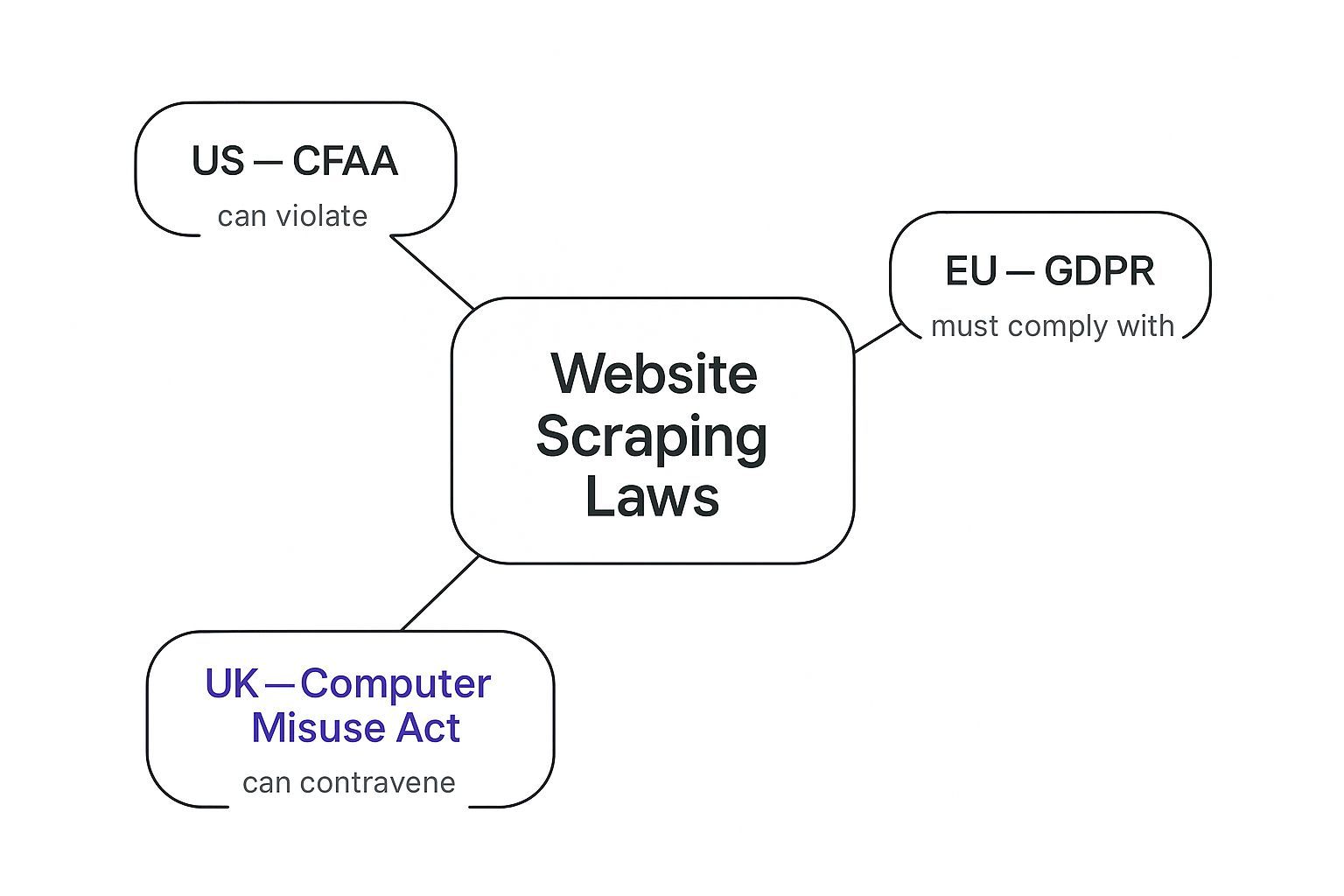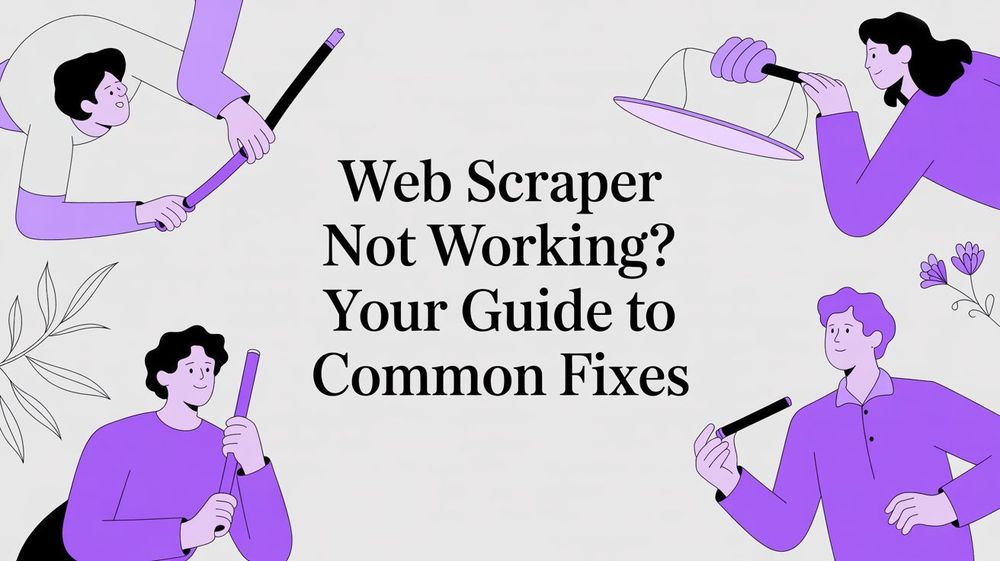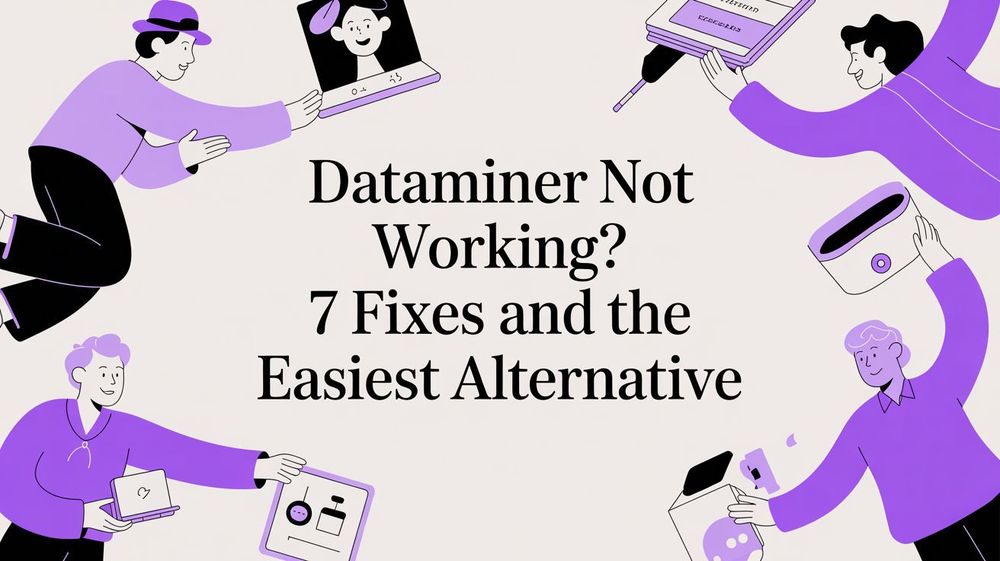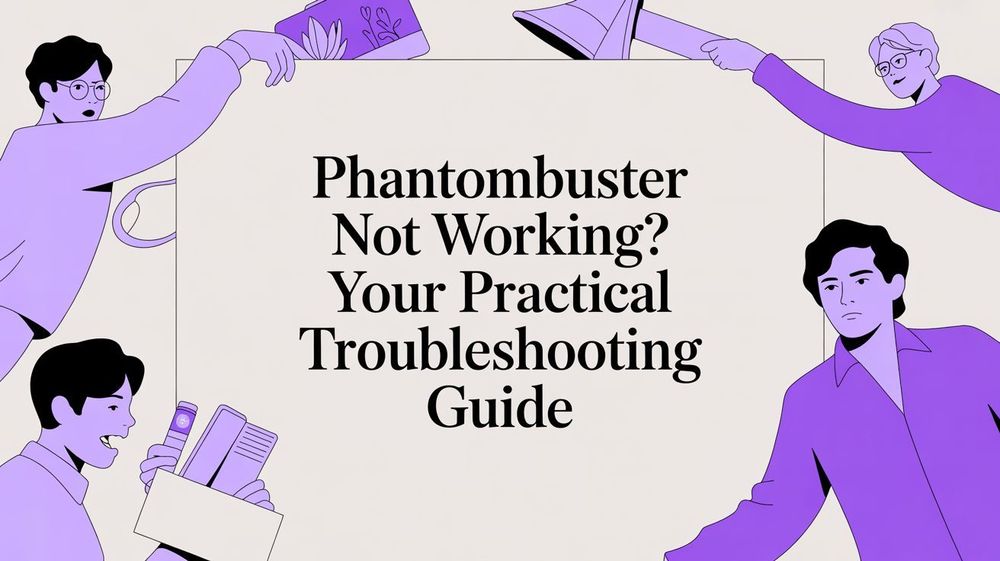Is website scraping legal? For recruiters, sales professionals, and researchers, this is a critical question. The short answer is: yes, when done correctly. The legality of scraping hinges on what you collect, how you collect it, and whether you respect the rules of the websites you visit.
For professionals who need to build candidate pipelines or lead lists from public sources, the good news is that scraping publicly available information—like job titles, company names, or professional profiles—is generally considered legal. The key is to operate ethically and use the right tools for the job.
Your Guide to Safe and Legal Website Scraping
Navigating the rules of website scraping can feel like decoding a complex legal document. But you're not trying to become a lawyer—you just want to build a powerful list of sales leads or find the perfect candidates for a role, quickly and efficiently.
The good news is that it doesn't have to be complicated. The entire concept boils down to one core idea: ethical scraping. This means gathering data in a way that is respectful, responsible, and compliant with the law.
Think of it like being a polite guest at a networking event. You wouldn’t interrupt conversations or cause a scene. Similarly, ethical scraping means staying out of password-protected areas and not overwhelming a website’s servers with so many requests that you slow it down for everyone else. This is a far cry from manual copy-pasting, which is slow and inefficient, or trying to code a scraper yourself, which is complex and full of legal pitfalls.
Key Factors in Scraping Legality
The single most important distinction is the difference between public and private data. Public data is anything you can see on a website without logging in. This is the sweet spot for recruiters and sales teams.
Here’s a quick summary of the main legal factors to keep in mind, framed for business value.
| Legal Factor | What It Means for Recruiters & Sales | Best Practice |
|---|---|---|
| Public vs. Private Data | If information is visible without a login (like public professional profiles), it's generally safe to collect. | Stick exclusively to public-facing information. Avoid anything behind a password wall to stay compliant. |
| Copyrighted Material | You can extract facts (names, titles, skills), but you can't copy entire articles, original images, or proprietary databases. | Focus on discrete data points for lead generation, not wholesale content. Never republish copyrighted text or media. |
| Personal Data | Privacy laws like GDPR in Europe have strict rules on handling personal information. This is critical for compliance. | Understand your obligations under privacy laws. Use tools designed for privacy-first data handling. |
| Terms of Service (ToS) | A site's ToS may forbid scraping. Violating these terms can get your IP address blocked, shutting down your data collection. | Read and respect the ToS. Use modern tools that mimic human behavior to reduce the risk of detection and blocking. |
Respecting these factors ensures your data gathering activities are safe, effective, and professional.
The Bottom Line: Public vs. Private is Key
Let's focus on what truly matters for a recruiter or sales pro.
The most crucial distinction you need to make is between public and private data. If any visitor can see the information without needing a password, the legal risk of scraping it is dramatically lower.
For professionals who need good data without the legal headache, building your own scripts is a risky path. Manual scraping is too slow, and custom-coded tools often miss these critical legal nuances, putting you in a tough spot.
This is where a modern, no-code tool like ProfileSpider offers a clear advantage. It’s built from the ground up to focus on extracting public profile data with a single click, keeping your workflow well within ethical and legal lines. It handles the technical and compliance challenges for you, so you can focus on what you do best: building high-quality candidate and lead lists.
Decoding the Rules of Data Scraping
To scrape data without running into trouble, you need to know the rules of the road. Let’s break down the core legal ideas into practical concepts you can actually use. The goal here is to understand the "why" behind the rules so you can make smarter, safer decisions when gathering leads.
A website's Terms of Service (ToS) acts like its digital rulebook. While the traditional method of manually checking a ToS is time-consuming, it’s a fast track to getting your IP address blocked if you ignore it. These documents often explicitly forbid automated data collection.
The Bright Line Between Public and Private Data
One of the biggest factors in the web scraping legal conversation is whether the data is public or hidden behind a login. Information that anyone on the internet can see without a password is far safer to collect. This is where a key U.S. law, the Computer Fraud and Abuse Act (CFAA), comes into play.
Originally designed to combat hacking, the CFAA makes it illegal to access a computer "without authorization." However, landmark court cases have clarified that scraping publicly available data does not count as unauthorized access.
In simple terms, if a website doesn't require a password to view information, you generally aren't "breaking in" by accessing it. This is a foundational principle for recruiters and sales pros who depend on public profiles for their work.
The moment you log in, the game changes. You've actively agreed to that site's rules, and scraping data from behind that login wall becomes a much riskier legal gray area.
This infographic gives you a quick visual on the primary legal frameworks you'll encounter.

Regulations like the CFAA in the U.S. and GDPR in the E.U. create a complex landscape, but it's one you can easily navigate with the right approach and tools.
Copyright and How Data Is Organized
Copyright is another piece of the puzzle. While you can't copyright simple facts—like a person's name or their job title—you can copyright the unique way a website organizes and presents that data.
- Individual Facts: Grabbing a name, company, or location from a profile? Generally not a copyright issue.
- Entire Database: Copying a website's entire, creatively structured database? That could be copyright infringement.
Think of it this way: you can write down the ingredients from a recipe (the facts), but you can't just photocopy the entire cookbook (the original, creative compilation). For lead generation, you're after the individual ingredients, not trying to publish your own version of the cookbook.
How to Read the Terms of Service
While the law sets the big-picture framework, a website's ToS adds another layer of rules. These agreements typically fall into two categories:
- Browsewrap Agreements: The terms you supposedly agree to just by using a site. They're often in a footer link and are less enforceable because most people never see them.
- Clickwrap Agreements: These require you to take a direct action, like checking a box that says, "I agree to the Terms of Service" during sign-up. These are much more likely to be legally binding.
Navigating these nuances is a major challenge for manual or coded scraping methods. In contrast, a tool like ProfileSpider is built for non-technical users and designed to focus on public data, which keeps it squarely aligned with legal precedents. You can see our philosophy in our Terms of Service. We handle the compliance heavy lifting so you can build your lead lists ethically, without needing to become a legal scholar.
How Landmark Court Cases Affect You
Legal theory provides the rules, but real-world court cases show us where the lines are drawn. For a recruiter sourcing candidates or a sales pro building a lead list, these legal battles directly impact your daily work. Understanding them is key to scraping data confidently and safely.
To appreciate why these court decisions are so important, you need to understand the meaning of legal precedent. In short, a major ruling sets a new standard that influences future legal decisions.
The Big One: hiQ Labs vs. LinkedIn
The case that reshaped the conversation around scraping is hiQ Labs vs. LinkedIn. HiQ, a data analytics firm, scraped publicly available data from LinkedIn profiles to offer companies insights on employee skills and retention.
LinkedIn sent them a cease-and-desist letter, arguing that hiQ was violating the Computer Fraud and Abuse Act (CFAA) by accessing its servers "without authorization."
However, the courts consistently sided with hiQ. The final decision established a crucial principle: scraping data that is publicly accessible and not locked behind a password wall does not violate the CFAA.
This was a monumental win for data scraping. The court affirmed that if information is public, companies can't use anti-hacking laws to block access and create information monopolies. For recruiters, this was a green light, confirming that collecting data from public professional profiles is generally permissible.
When Scraping Crosses the Line
Of course, it's not a total free-for-all. Other legal challenges have clarified where the boundaries lie.
Courts often use the CFAA to decide these cases, especially when a scraper bypasses a technical barrier. A more recent case, Meta vs. Bright Data, highlighted this. The court ruled that scraping even publicly viewable data can be "unauthorized access" if you have to circumvent contractual restrictions (like a login) to get it. This shows a legal gray area where each situation is judged on its merits.
These rulings highlight a crucial point for sales and recruiting professionals: how you collect data matters just as much as what you collect.
What These Cases Mean for Your Workflow
So, how does this legal history translate into action for you? The key takeaways provide a clear roadmap for compliant scraping.
- Public Data is Your Safe Zone: The hiQ vs. LinkedIn case provides a strong legal foundation for scraping publicly visible data.
- Respect "Gates": The moment a login or password wall appears, the rules change. Bypassing these technical barriers is what lands scrapers in trouble under the CFAA.
- Terms of Service Still Matter: Violating a site's ToS isn't a federal crime, but it's a fast way to get your IP address or account banned, grinding your workflow to a halt.
Trying to build a scraper yourself or using a poorly designed tool can easily push you into these gray areas. You might accidentally access data behind a login or scrape so aggressively that you trigger a site's defenses.
This is why a compliance-focused tool is the safest path. ProfileSpider was designed to operate within these legal precedents. By enabling one-click extraction of public profile data, it keeps your data gathering squarely in the "safe zone" established by the courts. It handles the technical compliance so you can build lead and candidate lists without worrying about the complex legal history that shaped the rules.
Navigating Global Privacy Laws Like GDPR
Your data collection doesn't happen in a vacuum. If you're a recruiter in Chicago sourcing candidates from Germany, or a sales pro in London targeting leads in California, you're operating on a global stage. This means you need to be familiar with international privacy laws—the biggest being Europe’s General Data Protection Regulation (GDPR).

While navigating international law sounds intimidating, the core concepts are straightforward. These rules set practical guidelines for anyone handling information about people and directly impact how you source profiles legally and ethically.
What Counts as Personal Data
First, you must understand what these laws mean by "personal data." The GDPR's definition is incredibly broad.
Personal data is any information that relates to an identified or identifiable individual. This includes a person’s name, email, phone number, IP address, and professional details like their job title and work history when linked to them.
Essentially, if any data you scrape can be tied back to a specific person, it’s personal data. For sales and recruiting professionals, nearly every piece of information on a professional profile falls under this umbrella, meaning you have a responsibility to handle it correctly.
Core Principles You Need to Know
You don't need a law degree, but a few core GDPR principles are non-negotiable for anyone building prospect or candidate lists. Understanding these highlights why manual scraping or poorly designed tools are so risky.
- Lawfulness, Fairness, and Transparency: You need a legitimate reason to collect data and must be transparent about it.
- Purpose Limitation: You can only collect data for a specific, explicit purpose. You can scrape a candidate’s profile for a job opening, but you can't reuse that data for an unrelated marketing campaign without consent.
- Data Minimization: Only collect what you absolutely need. If you're sourcing software engineers, you probably don't need their personal hobbies.
- Storage Limitation: Don't hoard data. Once you've filled a role or a lead goes cold, you should have a process for deleting their information.
These principles make it clear that the old "scrape everything and sort it out later" approach is not just sloppy—it's non-compliant. A basic script or a manual workflow lacks the built-in safeguards for purpose limitation or data minimization.
This is where a privacy-first tool becomes essential. Modern solutions like ProfileSpider are built with these complexities in mind. It operates with a focus on local data storage, giving you full control over the information you collect and delete. This design aligns with the principles of data minimization and storage limitation, simplifying compliance. To see how we commit to these standards, you can review our privacy policy.
A Practical Checklist for Ethical Scraping

Knowing the law is one thing; putting it into practice is what matters. An ethical approach isn't just about legal coverage; it’s about being a good citizen of the web. When you scrape a site, you're a guest. If you are aggressive and disruptive, you'll get kicked out.
Here's a simple checklist to keep your data gathering ethical, responsible, and effective.
Check the Robots.txt File First
Your first stop before launching any tool should be the robots.txt file. This is a simple text file on websites that lays out the rules for bots and scrapers. It's the digital "Do Not Disturb" sign, clearly stating which parts of the site are off-limits. Respecting these instructions is the bare minimum for ethical scraping. Ignoring them is a surefire way to get your IP address banned.
Scrape at a Human Pace
Imagine a person manually clicking through 100 professional profiles in a single minute. It's impossible. Aggressive scrapers that fire off hundreds of requests per second stick out and hammer a website's server, slowing it down for real users and triggering anti-bot defenses.
Responsible data collection is paced and patient. A good scraper builds in delays between requests to avoid disrupting the site's performance. This "low-and-slow" method is far less likely to get you detected.
The goal is to gather data without leaving a destructive footprint. By scraping at a respectful pace, you behave more like a regular visitor and less like a brute-force bot.
Websites are more sensitive to bot traffic than ever. In 2023, automated bots accounted for a staggering 49.6% of all internet traffic, with 32.0% classified as "bad" bot activity like aggressive scraping. You can explore the full report on global bot activity to see just how prevalent this has become.
The ProfileSpider Advantage: Automation with Ethics
Manually managing these best practices is a massive headache, especially if you're not a developer. How do you check the robots.txt file? How do you throttle your request rate? This is a common challenge for those using traditional methods.
If you build your own scripts or use basic tools, the entire compliance burden falls on your shoulders. One mistake can get you blocked, putting your lead generation on hold.
ProfileSpider was built to automate these best practices for you. It’s designed to be a good internet citizen, handling the technical compliance details behind the scenes.
- Built-in Respect for Rules: ProfileSpider operates in a way that aligns with ethical guidelines, reducing your risk of detection.
- Optimized Request Rates: The tool intelligently interacts with websites, mimicking human browsing patterns to avoid overwhelming servers.
- Focus on Public Data: By exclusively targeting publicly available profile information, it keeps your activities within the legal safe zones established by court rulings.
With ProfileSpider, you can get back to finding great candidates and leads instead of worrying about server loads and user-agent strings. It turns a complex, risky process into a simple, one-click workflow that’s both powerful and responsible.
A Modern, Compliant Way to Scrape Data
After navigating the legal maze of data scraping, it’s clear that traditional methods don't work for most business professionals. Building your own scripts or relying on basic tools is like walking through a minefield of legal and technical risks. It's an easy way to violate a website's Terms of Service, get your IP address blocked, or mishandle personal data under laws like GDPR.
For busy recruiters and sales teams, this isn't just an inconvenience—it's a threat to your productivity. Every hour spent wrestling with code or worrying about legal gray areas is an hour you’re not sourcing top candidates or closing deals.
From Risky Scripts to a Simple Click
A modern, no-code tool like ProfileSpider completely changes the game. It was built to solve the exact problems that make manual and coded scraping so risky for non-technical users. It handles the complex compliance work for you, right out of the box.
- The Manual/Coding Method: This approach forces you to be a part-time developer and legal expert. You’re responsible for respecting
robots.txtfiles, managing request speeds, and ensuring every action complies with laws like the CFAA and GDPR. - ProfileSpider's One-Click Workflow: Simply navigate to a page with the profiles you need, click one button, and the AI does the rest. It intelligently extracts structured data from public profiles while operating within established ethical guidelines, automating all the technical and legal heavy lifting.
ProfileSpider was designed with a privacy-first philosophy. By focusing only on publicly available information and storing all extracted data locally on your machine, it puts you in complete control and helps you adhere to the principles of data minimization and responsible collection.
Built for Compliant Lead Generation
ProfileSpider isn't just another scraper—it's a compliance-focused workflow tool. Every feature is designed to solve a real-world problem for professionals who need reliable data without taking on unnecessary risk. For teams automating these workflows, it's worth exploring platforms designed for regulatory adherence. You can find options by checking out resources on Top Software for Compliance.
This design philosophy allows you to build powerful candidate and lead databases with confidence. Our guide on how recruiters can use profile scraping shows exactly how to source top-tier candidates safely and efficiently. ProfileSpider takes the guesswork out of the website scraping legal equation, letting you get back to driving results.
Still Have Questions About Scraping Legality?
Even with a clear ethical strategy, you might have lingering questions. The legal side of web scraping can feel complex, so let’s clear things up with direct answers to common concerns.
Is It Illegal to Scrape LinkedIn or Facebook?
This is a critical question for recruiters and sales teams. Platforms like LinkedIn and Facebook have strict Terms of Service that explicitly forbid any kind of automated data scraping.
While the hiQ case affirmed scraping public data is not a CFAA violation, violating a site's ToS after logging in can still lead to account bans or legal action. The safest approach is to use tools designed to operate responsibly and ethically within these platforms' ecosystems, focusing only on data you are authorized to access.
Can I Get in Trouble for Scraping a Competitor's Prices?
Generally, scraping public pricing information is low-risk, as a price isn't considered personal data.
However, you must still be a good internet citizen. This means not overwhelming their servers with requests and respecting their robots.txt file. If your scraping is so aggressive it looks like a denial-of-service (DoS) attack, or if you copy their entire product catalog and republish it, you could run into trouble.
The goal is respectful competitive analysis, not disrupting their website. A slow and steady approach keeps you on the right side of the law.
What’s the Difference Between Data Scraping and Web Crawling?
These terms are often used interchangeably, but they describe very different tasks.
- Web Crawling is what search engines like Google do. It's a broad, exploratory mission to index the internet. Think of it as mapping the world.
- Data Scraping is a surgical strike. You have a specific target—like names, job titles, or contact info on a page—and your mission is to extract that structured data into a usable format, like a spreadsheet.
For sales, recruiting, or lead generation, you are data scraping. You’re not trying to map the web; you’re building focused, actionable lists to grow your business. ProfileSpider is the one-click solution designed specifically for this purpose.




